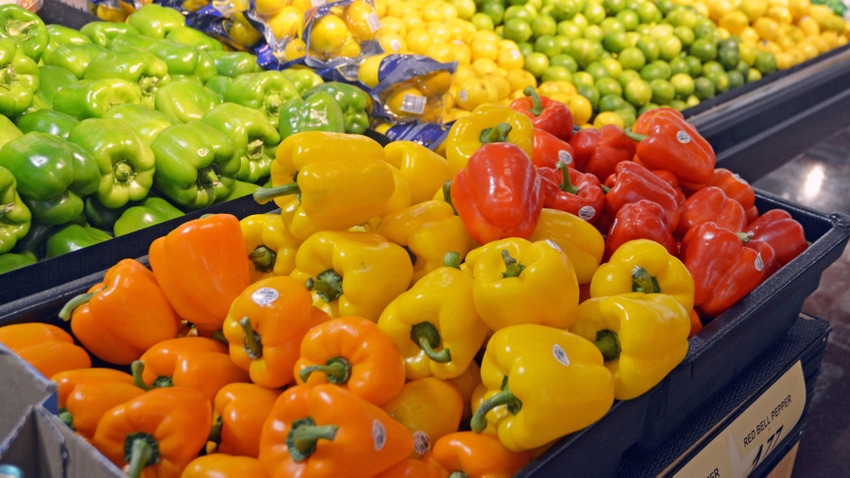March 24, 2023

Fresh produce imports from Mexico, which are a major source of economic activity in the Lower Rio Grande Valley of Texas and throughout the U.S., are expected to grow substantially in coming years, according to a recent report from the Center for North American Studies, CNAS, at Texas A&M University.
“Produce imports from Mexico will continue to increase over the next several years, and much of this growth will be seen through land ports in Texas,” said Luis Ribera, Ph.D., CNAS director, Bryan-College Station.
Ribera, Texas A&M AgriLife Extension Service economist in the Department of Agricultural Economics in Texas A&M College of Agriculture and Life Sciences, Bryan-College Station, was one of the report’s authors. Others who contributed to the report included Dean McCorkle, AgriLife Extension program specialist, Landyn Young, CNAS program coordinator, and Dan Hanselka, AgriLife Extension program specialist – all with the department.
Ribera said based on conservative assumptions, U.S. fresh produce imports from Mexico will increase by approximately 29.2% over 2022 levels. Using economic multipliers for each sector of the U.S. economy, these fresh produce imports from Mexico will increase business activity and provide a total economic impact of over $53 billion by 2030.

Aerial view of traffic waiting to cross the Texas-Mexico border. (Photo courtesy of the Texas A&M Transportation Institute)
“Produce imports have a competitive as well as a synergistic relationship with domestic production as Texas and U.S. cannot supply year-round fresh produce for consumption due to seasonality,” he said. “We produce, consume and export fresh produce in our production window and import the rest. That way, Texas and U.S. consumers can enjoy a year-round supply of their favorite fruits and vegetables.”
Of mutual benefit
“Our ability to import fruits and vegetables from other countries, as well as our ability to export them, is beneficial to consumers and the economy,” Ribera said. “Consumers can get the products they want when they want them, and the two-way trade serves to bolster both the Texas and U.S. economies. These imports also benefit our economy and create new jobs, especially in border states like Texas. Really, U.S. consumers are the main beneficiaries.”
Conversely, he said, about 30% of Texas’ agricultural exports go to Mexico, making it the largest international trading partner for agricultural products.
“Texas’ top five agricultural products are cotton, beef cattle and veal, feed grain products, dairy products and sorghum,” he said. “We are the No. 1 cotton exporter in the U.S. and rank second in both beef and wheat exports. We are also first in sheep and goat production, second in overall animal exports and are consistently among the top five U.S. states in the exportation of pecans, sorghum, rice and dairy products.”
Estimating future imports
More than 98% percent of produce imports from Mexico enter the U.S. by way of land ports between Texas, New Mexico, Arizona and California.
In an effort to quantify how much the U.S. produce imports from Mexico are expected to grow by 2030, the report’s authors used a conservative linear trend forecasting approach based on trends present from 2007-2022.
“This gave us a baseline for growth in imports from Mexico, assuming the future will be reflective of the past,” Ribera said. “The estimate also assumes that the mix of imports will remain relatively stable over the time period.”
Imports of produce from Mexico to the U.S. during 2022 totaled an estimated $18.7 billion, which included the importation of fresh, frozen and processed fruits, vegetables and nuts.
“When looking at only fresh fruits and vegetables, which is nearly 89% of the total, those imports alone totaled $16.6 billion,” Ribera said.
He said in 2022 about 590,906 truckloads of imported produce were shipped from Mexico to the U.S. in 40,000-pound loads, with about 55% percent of fresh fruit and vegetables entering through Texas land ports.
According to the report, U.S. fresh produce imports from Mexico by truck will increase to 763,416 truckloads by 2030, or 29.2% above 2022 levels. Most of this growth will occur through Texas ports, with imports expected to grow by 32.4% to 430,772 truckloads.
By 2030, Texas will account for 56.4% of all U.S. produce imports from Mexico, compared to 55% in 2022.
“The growth in imports has implications throughout the border economy in general, and Texas in particular,” Ribera said.
Ribera said U.S. imports of fresh produce from Mexico at the retail level were estimated using IMPLAN, an economic input/output model.
“Economic multipliers for each sector of the economy were used to estimate how fresh produce imports from Mexico will impact business activity, income and employment in other sectors of the economy that supply inputs and services to the fresh produce supply chain,” he said. “This is from the moment the products reach the U.S. ports of entry all the way to the retail of those products.”
He said when considering the entire U.S./Mexico border region of Texas, New Mexico, Arizona and California, there was an estimated $14.84 billion of direct economic output attributed to produce imports from Mexico during 2022. This led to an additional $25.96 billion impact in economic activity from supporting industries for a total economic impact of $40.80 billion.
The next seven years
By 2030, the direct economic output from these imports is expected to grow to $19.17 billion. Retail and wholesale outlets will be the main beneficiaries, followed by truck transportation and other services. Ribera said.
“This direct output will require an additional $34.18 billion in economic activity from supporting industries for a total economic impact of $53.3 billion,” Ribera said.
Some of those leading supporting industries in 2030 are expected to include real estate, enterprise management, warehousing and storage, monetary authorities, hospitals, electric power transmission, insurance carriers, petroleum refineries and employment services.
“Total employment in the four-state border region and throughout the U.S. associated with handling fresh produce imports in 2030 is estimated at 318,725 jobs,” Ribera said. “Most of those jobs would be in retail, followed by wholesale, then jobs in the transportation sector, real estate jobs, and jobs in warehousing and storage.”
He said for produce imports going through Texas alone, the total economic activity to support the additional imports will be $34.13 billion, along with 204,519 jobs.
Preparing for the future
“A large portion of the state’s agricultural production and movement takes place in the Rio Grande Valley,” said Rudy Nayga, Ph.D., head of Texas A&M’s Department of Agricultural Economics.
Nayga said to help meet the needs and address challenges for agriculture and agribusiness in the Rio Grande Valley now and in the future, a key group of agricultural economics faculty members has been selected to teach and conduct research at the Texas A&M University Higher Education Center in McAllen.

The Texas A&M University Higher Education Center in McAllen has added agricultural economics faculty members to help meet the needs of the agricultural community in the Rio Grande Valley. (Texas A&M AgriLife photo)
He said this way Texas A&M can be responsive to the needs of Texas and provide increased educational opportunities for those interested in a career in agriculture, as well as conduct research for and give technical assistance to those who are already involved in agriculture.
“We felt it was important to have a strong presence in this part of the state due to the size and needs of the agricultural community, as well as the sheer volume of agricultural imports and exports that pass through the region,” he said.
Source: Texas A&M AgriLife Today
Read more about:
ImportsAbout the Author(s)
You May Also Like




